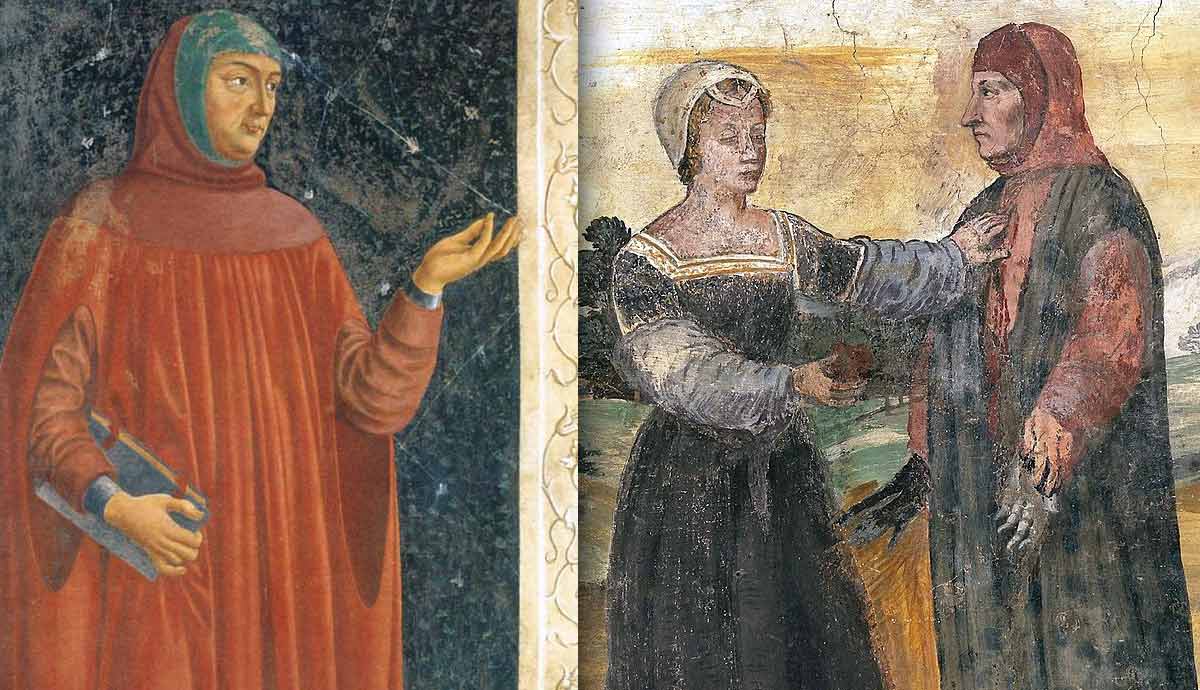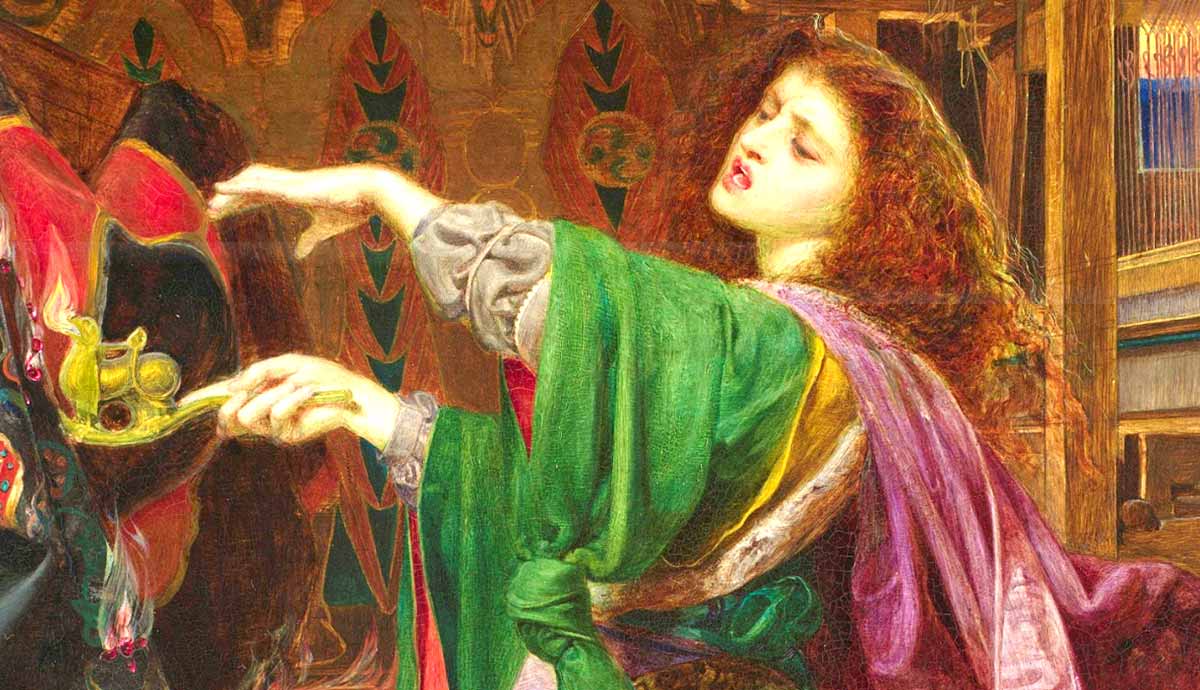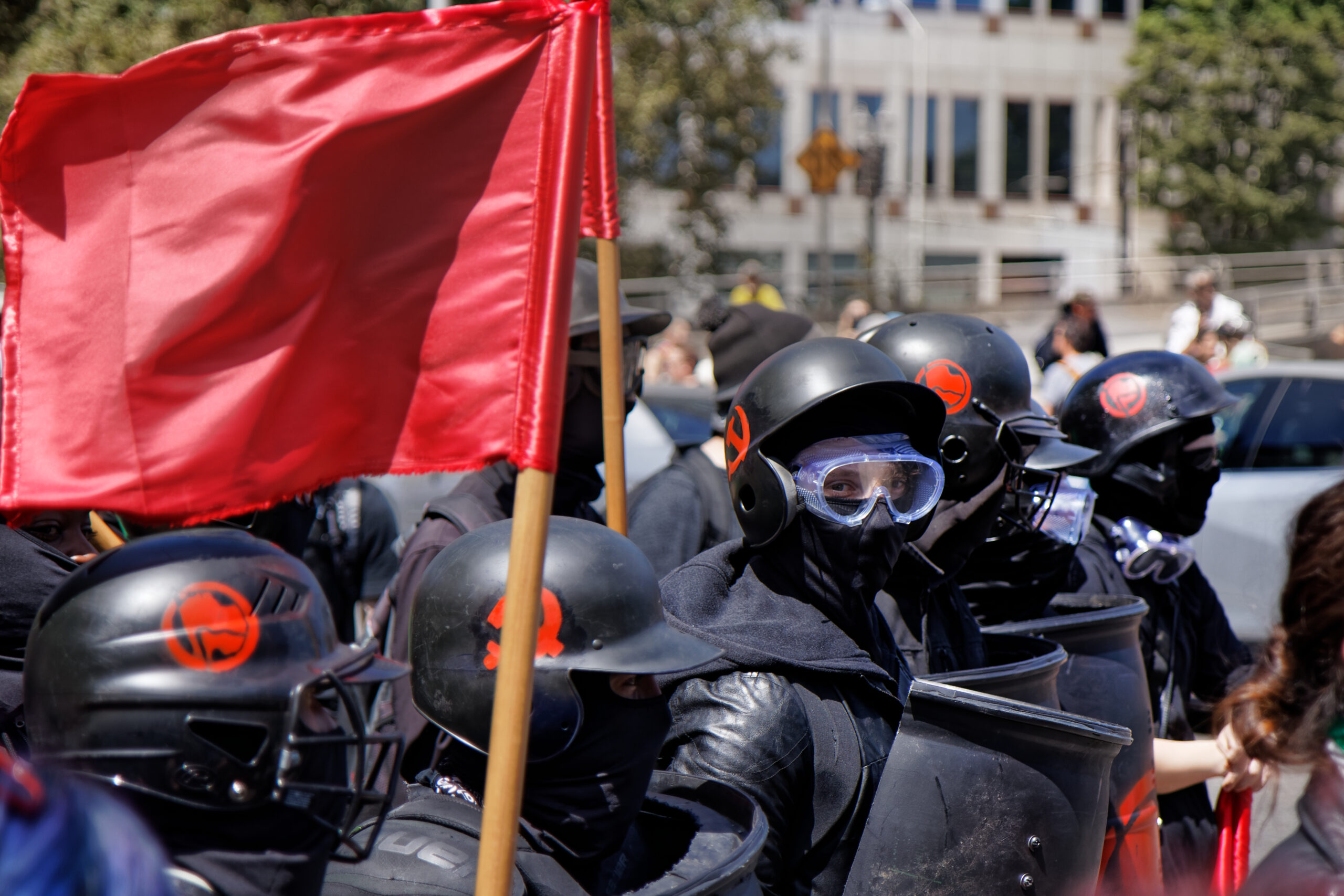0 Commentaires
0 Parts
147 Vue

Annuaire
Elevate your Sngine platform to new levels with plugins from YubNub Digital Media!
-
Connectez-vous pour aimer, partager et commenter!
-
 YUBNUB.NEWSRubio Condemns Conviction of Former Brazil President Bolsonaro, Says US Will ActSecretary of State Marco Rubio speaks to reporters before boarding his plane at Homestead Air Reserve Base in Homestead, Fla., on Sept. 2, 2025. Jacquelyn Martin/Pool via ReutersU.S. State Secretary Marco0 Commentaires 0 Parts 145 Vue
YUBNUB.NEWSRubio Condemns Conviction of Former Brazil President Bolsonaro, Says US Will ActSecretary of State Marco Rubio speaks to reporters before boarding his plane at Homestead Air Reserve Base in Homestead, Fla., on Sept. 2, 2025. Jacquelyn Martin/Pool via ReutersU.S. State Secretary Marco0 Commentaires 0 Parts 145 Vue -
 WWW.THECOLLECTOR.COMHow Francesco Petrarch Shaped Humanism & Paved the Way to the RenaissanceBorn in Arezzo, Italy, in 1304, Francesco Petrarch devoted his life to the study of Classical authors and literature. A frequent traveler throughout Europe due to his diplomatic activities, Petrarch came into contact with several men of learning and became a leading scholar and poet. In 1341, he was crowned as poet laureate in Rome. Petrarchs Il Canzoniere, a collection of poems focusing on his love for Laura, had a lasting impact on European literature, influencing Renaissance lyric poetry with its form and language.Quick Facts About PetrarchFactDetailFull nameFrancesco Petrarca (anglicized as Petrarch)Born1304 Arezzo, Tuscany, ItalyFamilyFather Ser Petracco (Pietro); mother Eletta Canigiani; one younger brother GherardoEducationStudied law at Carpentras, Montpellier, and the University of Bologna before turning to Classical literatureEarly patronCardinal Giovanni Colonna in Avignon (from 1326)Church careerTook minor ecclesiastical vows in 1333 for financial independenceMajor worksIl Canzoniere (366 poems), Secretum meum, De viris illustribusScholarly achievementsRediscovered lost works of Cicero (incl. letters to Atticus, Brutus, Quintus) and assembled the eras finest private libraryPeak honorCrowned Poet Laureate of Rome in 1341the first since antiquityLegacyKey figure of early Humanism; bridged Middle Ages and Renaissance; inspired Petrarchism across EuropeDiedJuly 1374 at Arqu (today Arqu Petrarca), Veneto, ItalyFrancesco Petrarchs Early YearsView of Arezzo, the Tuscan city where Petrarch was born in 1304, photograph by Bultro, 2008. Source: Wikimedia CommonsPetrarch was born Francesco Petrarca in 1304 in Arezzo, Tuscany. Three years later, when the family was living in Incisa in Val dArno, Petrarchs parents had another son, Gherardo. His father, Ser Petracco (a nickname for Pietro), had to leave his hometown of Florence in 1302 after the White Guelfs, the political faction he supported, were ousted by the opposing Black Guelfs. In the same year, poet Dante Alighieri, also a supporter of the White Guelfs, was similarly exiled from Florence, never to return.In 1312, Ser Petracco left Italy for Avignon, taking his wife and two children with him. In Avignon, the southern French city where the papacy had relocated in 1309, Petrarchs father secured a place as a notary at the papal court and encouraged his sons to follow in his footsteps. Thus, Francesco was sent to Carpentras and then Montpellier to study law. In 1320, Petrarch and his brother Gherardo returned to Italy to continue their studies at the renowned University of Bologna.The Papal Palace in Avignon, France, where the popes resided between 1309 and 1377. Photograph by Paolo Picciati. Source: Wikimedia CommonsWhile young Francesco enjoyed his time in Bologna (I do not think that one could find a more beautiful or more free place in all the world), he was not passionate about his studies, preferring Classical texts and literature to law books. During this period, he also began collecting books and manuscripts, a habit that would ultimately lead him to own the most extensive and remarkable private library of his time.In 1326, after his fathers death, Francesco Petrarch abandoned his law studies to focus on literature and the humanities. In need of financial stability, he left Bologna for Avignon, where he managed to secure the patronage of the wealthy and influential Cardinal Giovanni Colonna. In 1333, Petrarch took minor ecclesiastical vows, a decision that would allow him to gain a greater financial independence and pursue a career in the Catholic Church.Taking the orders did not prevent Petrarch from enjoying the earthly pleasures offered by the polished papal court of Avignon. For the rest of his life, the poet would be torn between his religious faith and his desire for prestige.A Love for Classical Culture: Petrarch & HumanismFrancesco Petrarca depicted in the cycle Famous Persons by Andrea del Castagno, ca. 1450. Source: Wikimedia Commons/Uffizi Gallery, FlorenceIn the 1330s, Francesco Petrarch traveled extensively throughout Europe, visiting France, Flanders, Brabant, and the Rhineland. Unlike Dante, who was deeply involved with the political life of his hometown and spent his life yearning to return to the bellovile (beloved fold), Petrarch described himself as rootless: I am a citizen of no place, everywhere I am a stranger.While the lack of a stable homeland left the poet feeling restless (Jacob Burckhardt called him the first truly modern man), the constant wandering allowed Petrarch to come in contact with the most influential men of learning of his time and search for lost classical manuscripts in libraries. In Lige, for example, he recovered copies of two speeches penned by Cicero. In 1345, while residing in Verona, he discovered Ciceros letters to Atticus, Brutus, and Quintus.Manuscript of one of Ciceros letters discovered by Petrarch, Plutei 49.18, fol. 82 verso, c. 14th century CE. Source: Biblioteca Medicea LaurenzianaThroughout his life, Petrarch repeatedly drew on Classical authors and works as a source of literary and, most importantly, moral inspiration. While Dante also turned to Classical culture as a basis for his Commedia (the Latin scholar Virgil served as a guide during his journey through Hell, Purgatory, and Paradise), the Florentine poet, like his fellow medieval scholars, did not view the Classical world as a historical period distinct from his own. Thus, he assimilated tropes and figures of Classical culture directly into his Christian worldview, presenting them as allegories or metaphors of the Christian message.Petrarchs attitude to the Classics significantly differed from that of Dante. A deeply humanist scholar, Petrarch promoted the continuity between antiquity and 14th-century society. However, he approached the Classical texts as a philologue, recovering, editing, transcribing, annotating, and stripping them of their religious allegorical readings. In this sense, Petrarchs study of the Classical authors laid the foundations for the Renaissance movement. Rejecting the sterile arguments of medieval Scholasticism, he promoted the values of Classical culture in an attempt to reconcile the pagan world with Christian doctrine.The idea of continuity between the two worlds is evident in his De viris illustribus (On Illustrious Men), a collection of biographies (written in Latin) of heroes of Greek and Roman history as well as Biblical figures.A Modern Man: Crisis & Self-DiscoveryView of Mount Ventoux seen from Avignon. Petrarch described his climb on Mount Ventoux in a famous letter. Source: Wikimedia CommonsWhile Petrarch managed to reconcile his admiration for the pagan Classical culture with Christianity, the poet experienced a profound moral crisis born from his pursuit of earthly pleasures and the inability to lead his life according to his religious faith, rejecting worldly affairs to find peace in God. Likely precipitated by his brothers decision to enter monastic life, Petrarchs inner conflict underlies his theological and literary works.At the height of his crisis, around 1342 and 1343, shortly after being crowned poet laureate in Rome, Petrarch addressed his inner duality in Secretum meum, a treatise consisting of three imaginary dialogues between the poet and St. Augustine in the presence of a beautiful woman, an allegory of the Truth.Despite the Father of the Churchs guidance, however, Petrarchs anguish and feelings remain unresolved. The inner peace the poet yearns for, ultimately, remains beyond his reach. In his self-awareness and crisis, Petrarch is no longer a medieval man. He foreshadows the Renaissance movement and, even, modernity.Le pitture antiche delle grotte di Roma, engraving by Giovanni Pietro Bellori, 1706. Petrarch promoted the recovery of Classical culture. Source: University of Chicago LibraryCritics have seen traces of Petrarchs shift away from the medieval way of thinking in a letter written by the poet to his friend, supposedly in 1336. In the missive, Petrarch described his and Gherardos ascent to Mount Ventoux. In particular, the act of climbing to the top of the mountain to admire the surrounding vast landscape and admire the beauty of nature is often cited as a mark of Petrarchs Humanism and a prefiguration of the Renaissance.In the letter, however, the ascent to the mountain is less a premonition of things to come and more an allegory of Petrarchs inner crisis. While his brother takes a path leading straight to the peak, the poets chosen path is more tortuous, causing him to descend to valleys and to lose his way several timesa clear allegory to Petrarchs inability to resist temptation.The conflict between the two opposing forces coexisting in his psyche is directly referenced in the letter: These two adversaries have joined in close combat for the supremacy, and for a long time now a harassing and doubtful war has been waged in the field of my thoughts.Francesco Petrarchs Il CanzoniereLaura and Petrarch in a fresco adorning the poets house in Arqu. Source: Wikimedia CommonsPetrarchs inner conflict is also at the center of his most famous poetic work, Il Canzoniere. Also known as Rerum volgarium fragmenta (Fragments of Vernacular Matters) and Rime (from the first verse of its first poem), Il Canzoniere is a collection of 366 poems (songs, sestine, ballads, and madrigals), including 317 sonnets. Petrarch wrote the poems over a period of about forty years until his death in 1347, often revising and editing his verses.The central theme in Il Canzoniere is Petrarchs courtly love for Laura, a married woman he allegedly saw for the first time on April 26, 1327, in the church of St. Clair of Avignon, and loved from afar until her death in 1348 during the plague pandemic known as the Black Death. Little is known about Laura, as Petrarch offered only sparse information about her in his works. As a result, efforts to identify her have been unsuccessful. At the same time, the suggestion that she was a figment of Petrarchs imagination has been discarded by most scholars.The first poem of Il Canzoniere in a 15th-century manuscript made for Francesco III da Montefeltro, Duke of Urbino. Source: Wikimedia CommonsIn the final draft of Il Canzoniere, Petrarch arranged the poems chronologically and divided them into two parts: Rime in vita di Laura (Poems During Lauras Life) and Rime in morte di Laura (Poems After Lauras Death). Besides illustrating the evolution of his love for Laura, the chronological arrangement of the collection had the clear goal of serving as an allegory for the poets own inner journey, from the errors of his youth to the later asceticism, from the pursuit of worldly glory to the search for God.Like in other works, however, Il Canzoniere does not offer a definitive solution to Petrarchs split psyche. The poet, however, did not translate his sense of restlessness into his lyrics. Indeed, his poems are limpid and precise in both structure and language. The harmonious form and lyrics were the result of Petrarchs careful avoidance of terms that may be too emotionally charged or sound harsh.Francesco Petrarchs Later Years & LegacyPetrarchs house in Arqu (now Arqu Petrarca) on the Euganean Hills in Veneto, photograph by Alain Rouiller, 2009. Source: Wikimedia CommonsConcentrated on his inner conflicts, Petrarch was not directly involved in the political landscape of the 14th-century Italian peninsula. In 1347, he lent his support to Cola di Rienzos unsuccessful attempt to restore Rome as the capital of Italy and reestablish a Roman Republic. His backing for Di Rienzo cost him the loss of the patronage of Cardinal Colonna, whose influential family firmly opposed Colas ambitious project.Around the same years, tired of the constant maneuvering of the Avignon court, Petrarch moved to Padua, where his new patron, Jacopo II da Carrara, made him canon of the citys cathedral. In the following years, he went to Milan, Parma, Verona, and Venice. Though he took part in various diplomatic missions, Petrarch longed for the quiet he found in his house in Arqu (now Arqu Petrarca), a small town on the Euganean Hills near Padua. It was in his Arqu residence that Francesco Petrarch died in July 1374. According to legend, he was found with his head reclining over a manuscript of Virgil.Statue of Petrarch in the Uffizi Gallery. Source: Wikimedia CommonsFor centuries after his death, Petrarch had a profound impact on European literature, not only in Italy but also in Spain, France, and England, where his legacy gave rise to a literary phenomenon known as Petrarchism. His poems and lyrical style influenced generations of poets and scholars, who accepted his Canzoniere as the standard by which other works would be judged.Petrarchs influence and legacy, however, were not merely a matter of form, but rather of a new way of thinking. Standing between the Middle Ages and the Renaissance, he embodied the humanist spirit, foreshadowing a new era and a new attitude toward the past, religion, and the human experience.0 Commentaires 0 Parts 151 Vue
WWW.THECOLLECTOR.COMHow Francesco Petrarch Shaped Humanism & Paved the Way to the RenaissanceBorn in Arezzo, Italy, in 1304, Francesco Petrarch devoted his life to the study of Classical authors and literature. A frequent traveler throughout Europe due to his diplomatic activities, Petrarch came into contact with several men of learning and became a leading scholar and poet. In 1341, he was crowned as poet laureate in Rome. Petrarchs Il Canzoniere, a collection of poems focusing on his love for Laura, had a lasting impact on European literature, influencing Renaissance lyric poetry with its form and language.Quick Facts About PetrarchFactDetailFull nameFrancesco Petrarca (anglicized as Petrarch)Born1304 Arezzo, Tuscany, ItalyFamilyFather Ser Petracco (Pietro); mother Eletta Canigiani; one younger brother GherardoEducationStudied law at Carpentras, Montpellier, and the University of Bologna before turning to Classical literatureEarly patronCardinal Giovanni Colonna in Avignon (from 1326)Church careerTook minor ecclesiastical vows in 1333 for financial independenceMajor worksIl Canzoniere (366 poems), Secretum meum, De viris illustribusScholarly achievementsRediscovered lost works of Cicero (incl. letters to Atticus, Brutus, Quintus) and assembled the eras finest private libraryPeak honorCrowned Poet Laureate of Rome in 1341the first since antiquityLegacyKey figure of early Humanism; bridged Middle Ages and Renaissance; inspired Petrarchism across EuropeDiedJuly 1374 at Arqu (today Arqu Petrarca), Veneto, ItalyFrancesco Petrarchs Early YearsView of Arezzo, the Tuscan city where Petrarch was born in 1304, photograph by Bultro, 2008. Source: Wikimedia CommonsPetrarch was born Francesco Petrarca in 1304 in Arezzo, Tuscany. Three years later, when the family was living in Incisa in Val dArno, Petrarchs parents had another son, Gherardo. His father, Ser Petracco (a nickname for Pietro), had to leave his hometown of Florence in 1302 after the White Guelfs, the political faction he supported, were ousted by the opposing Black Guelfs. In the same year, poet Dante Alighieri, also a supporter of the White Guelfs, was similarly exiled from Florence, never to return.In 1312, Ser Petracco left Italy for Avignon, taking his wife and two children with him. In Avignon, the southern French city where the papacy had relocated in 1309, Petrarchs father secured a place as a notary at the papal court and encouraged his sons to follow in his footsteps. Thus, Francesco was sent to Carpentras and then Montpellier to study law. In 1320, Petrarch and his brother Gherardo returned to Italy to continue their studies at the renowned University of Bologna.The Papal Palace in Avignon, France, where the popes resided between 1309 and 1377. Photograph by Paolo Picciati. Source: Wikimedia CommonsWhile young Francesco enjoyed his time in Bologna (I do not think that one could find a more beautiful or more free place in all the world), he was not passionate about his studies, preferring Classical texts and literature to law books. During this period, he also began collecting books and manuscripts, a habit that would ultimately lead him to own the most extensive and remarkable private library of his time.In 1326, after his fathers death, Francesco Petrarch abandoned his law studies to focus on literature and the humanities. In need of financial stability, he left Bologna for Avignon, where he managed to secure the patronage of the wealthy and influential Cardinal Giovanni Colonna. In 1333, Petrarch took minor ecclesiastical vows, a decision that would allow him to gain a greater financial independence and pursue a career in the Catholic Church.Taking the orders did not prevent Petrarch from enjoying the earthly pleasures offered by the polished papal court of Avignon. For the rest of his life, the poet would be torn between his religious faith and his desire for prestige.A Love for Classical Culture: Petrarch & HumanismFrancesco Petrarca depicted in the cycle Famous Persons by Andrea del Castagno, ca. 1450. Source: Wikimedia Commons/Uffizi Gallery, FlorenceIn the 1330s, Francesco Petrarch traveled extensively throughout Europe, visiting France, Flanders, Brabant, and the Rhineland. Unlike Dante, who was deeply involved with the political life of his hometown and spent his life yearning to return to the bellovile (beloved fold), Petrarch described himself as rootless: I am a citizen of no place, everywhere I am a stranger.While the lack of a stable homeland left the poet feeling restless (Jacob Burckhardt called him the first truly modern man), the constant wandering allowed Petrarch to come in contact with the most influential men of learning of his time and search for lost classical manuscripts in libraries. In Lige, for example, he recovered copies of two speeches penned by Cicero. In 1345, while residing in Verona, he discovered Ciceros letters to Atticus, Brutus, and Quintus.Manuscript of one of Ciceros letters discovered by Petrarch, Plutei 49.18, fol. 82 verso, c. 14th century CE. Source: Biblioteca Medicea LaurenzianaThroughout his life, Petrarch repeatedly drew on Classical authors and works as a source of literary and, most importantly, moral inspiration. While Dante also turned to Classical culture as a basis for his Commedia (the Latin scholar Virgil served as a guide during his journey through Hell, Purgatory, and Paradise), the Florentine poet, like his fellow medieval scholars, did not view the Classical world as a historical period distinct from his own. Thus, he assimilated tropes and figures of Classical culture directly into his Christian worldview, presenting them as allegories or metaphors of the Christian message.Petrarchs attitude to the Classics significantly differed from that of Dante. A deeply humanist scholar, Petrarch promoted the continuity between antiquity and 14th-century society. However, he approached the Classical texts as a philologue, recovering, editing, transcribing, annotating, and stripping them of their religious allegorical readings. In this sense, Petrarchs study of the Classical authors laid the foundations for the Renaissance movement. Rejecting the sterile arguments of medieval Scholasticism, he promoted the values of Classical culture in an attempt to reconcile the pagan world with Christian doctrine.The idea of continuity between the two worlds is evident in his De viris illustribus (On Illustrious Men), a collection of biographies (written in Latin) of heroes of Greek and Roman history as well as Biblical figures.A Modern Man: Crisis & Self-DiscoveryView of Mount Ventoux seen from Avignon. Petrarch described his climb on Mount Ventoux in a famous letter. Source: Wikimedia CommonsWhile Petrarch managed to reconcile his admiration for the pagan Classical culture with Christianity, the poet experienced a profound moral crisis born from his pursuit of earthly pleasures and the inability to lead his life according to his religious faith, rejecting worldly affairs to find peace in God. Likely precipitated by his brothers decision to enter monastic life, Petrarchs inner conflict underlies his theological and literary works.At the height of his crisis, around 1342 and 1343, shortly after being crowned poet laureate in Rome, Petrarch addressed his inner duality in Secretum meum, a treatise consisting of three imaginary dialogues between the poet and St. Augustine in the presence of a beautiful woman, an allegory of the Truth.Despite the Father of the Churchs guidance, however, Petrarchs anguish and feelings remain unresolved. The inner peace the poet yearns for, ultimately, remains beyond his reach. In his self-awareness and crisis, Petrarch is no longer a medieval man. He foreshadows the Renaissance movement and, even, modernity.Le pitture antiche delle grotte di Roma, engraving by Giovanni Pietro Bellori, 1706. Petrarch promoted the recovery of Classical culture. Source: University of Chicago LibraryCritics have seen traces of Petrarchs shift away from the medieval way of thinking in a letter written by the poet to his friend, supposedly in 1336. In the missive, Petrarch described his and Gherardos ascent to Mount Ventoux. In particular, the act of climbing to the top of the mountain to admire the surrounding vast landscape and admire the beauty of nature is often cited as a mark of Petrarchs Humanism and a prefiguration of the Renaissance.In the letter, however, the ascent to the mountain is less a premonition of things to come and more an allegory of Petrarchs inner crisis. While his brother takes a path leading straight to the peak, the poets chosen path is more tortuous, causing him to descend to valleys and to lose his way several timesa clear allegory to Petrarchs inability to resist temptation.The conflict between the two opposing forces coexisting in his psyche is directly referenced in the letter: These two adversaries have joined in close combat for the supremacy, and for a long time now a harassing and doubtful war has been waged in the field of my thoughts.Francesco Petrarchs Il CanzoniereLaura and Petrarch in a fresco adorning the poets house in Arqu. Source: Wikimedia CommonsPetrarchs inner conflict is also at the center of his most famous poetic work, Il Canzoniere. Also known as Rerum volgarium fragmenta (Fragments of Vernacular Matters) and Rime (from the first verse of its first poem), Il Canzoniere is a collection of 366 poems (songs, sestine, ballads, and madrigals), including 317 sonnets. Petrarch wrote the poems over a period of about forty years until his death in 1347, often revising and editing his verses.The central theme in Il Canzoniere is Petrarchs courtly love for Laura, a married woman he allegedly saw for the first time on April 26, 1327, in the church of St. Clair of Avignon, and loved from afar until her death in 1348 during the plague pandemic known as the Black Death. Little is known about Laura, as Petrarch offered only sparse information about her in his works. As a result, efforts to identify her have been unsuccessful. At the same time, the suggestion that she was a figment of Petrarchs imagination has been discarded by most scholars.The first poem of Il Canzoniere in a 15th-century manuscript made for Francesco III da Montefeltro, Duke of Urbino. Source: Wikimedia CommonsIn the final draft of Il Canzoniere, Petrarch arranged the poems chronologically and divided them into two parts: Rime in vita di Laura (Poems During Lauras Life) and Rime in morte di Laura (Poems After Lauras Death). Besides illustrating the evolution of his love for Laura, the chronological arrangement of the collection had the clear goal of serving as an allegory for the poets own inner journey, from the errors of his youth to the later asceticism, from the pursuit of worldly glory to the search for God.Like in other works, however, Il Canzoniere does not offer a definitive solution to Petrarchs split psyche. The poet, however, did not translate his sense of restlessness into his lyrics. Indeed, his poems are limpid and precise in both structure and language. The harmonious form and lyrics were the result of Petrarchs careful avoidance of terms that may be too emotionally charged or sound harsh.Francesco Petrarchs Later Years & LegacyPetrarchs house in Arqu (now Arqu Petrarca) on the Euganean Hills in Veneto, photograph by Alain Rouiller, 2009. Source: Wikimedia CommonsConcentrated on his inner conflicts, Petrarch was not directly involved in the political landscape of the 14th-century Italian peninsula. In 1347, he lent his support to Cola di Rienzos unsuccessful attempt to restore Rome as the capital of Italy and reestablish a Roman Republic. His backing for Di Rienzo cost him the loss of the patronage of Cardinal Colonna, whose influential family firmly opposed Colas ambitious project.Around the same years, tired of the constant maneuvering of the Avignon court, Petrarch moved to Padua, where his new patron, Jacopo II da Carrara, made him canon of the citys cathedral. In the following years, he went to Milan, Parma, Verona, and Venice. Though he took part in various diplomatic missions, Petrarch longed for the quiet he found in his house in Arqu (now Arqu Petrarca), a small town on the Euganean Hills near Padua. It was in his Arqu residence that Francesco Petrarch died in July 1374. According to legend, he was found with his head reclining over a manuscript of Virgil.Statue of Petrarch in the Uffizi Gallery. Source: Wikimedia CommonsFor centuries after his death, Petrarch had a profound impact on European literature, not only in Italy but also in Spain, France, and England, where his legacy gave rise to a literary phenomenon known as Petrarchism. His poems and lyrical style influenced generations of poets and scholars, who accepted his Canzoniere as the standard by which other works would be judged.Petrarchs influence and legacy, however, were not merely a matter of form, but rather of a new way of thinking. Standing between the Middle Ages and the Renaissance, he embodied the humanist spirit, foreshadowing a new era and a new attitude toward the past, religion, and the human experience.0 Commentaires 0 Parts 151 Vue -
 WWW.THECOLLECTOR.COMThe Infamous Sorceress Morgan le Fay of Arthurian LegendToday, one of the most popular characters from the Arthurian legends is undoubtedly Morgan le Fay. She is often presented as a cunning, alluring, evil sorceress who plots against King Arthur. While this basic description matches fairly well with some medieval portrayals of her, it is only part of her story. In fact, some versions of the Arthurian legend portray her as a thoroughly supportive ally of Arthur. In this article, we will analyze how the character of Morgan le Fay evolved over the centuries as the Arthurian legends developed.The Famous Version of Morgan le FayShe was known to have studied magic while she was being brought up in the nunnery, by William Henry Margetson, 1914. Source: University of RochesterFirst, let us consider an overview of the character of Morgan le Fay as she is presented in the most well-known adaptation of the Arthurian legend. This is Le Morte dArthur, written by Thomas Malory in the 15th century. This English work remains the most influential version of the legend today. In this work, Morgan le Fay is portrayed as Arthurs older half-sister. She is the daughter of Arthurs mother, Igraine, by her first husband, Gorlois.Malory presents Morgan as the source of considerable conflict during Arthurs reign. She threatens Arthurs rule in a number of ways, both directly and indirectly. She is presented as being essentially completely hostile to Arthur and evil in nature. She is a sorceress dealing with enchantments and potions. At the end of the story, Morgan has a sudden and unexplained change of behavior towards Arthur. After Arthur is mortally wounded at the Battle of Camlann, Morgan is one of the women who arrive in a boat to take him to Avalon to heal him.Morgan le Fays Earliest AppearanceThe Last Sleep of Arthur in Avalon, by Edward Burne-Jones, 1898. Source: Wikimedia CommonsThis portrayal of Morgan is very different from how she is shown in her first appearance. The very earliest surviving source to mention Morgan le Fay is Geoffrey of Monmouths Vita Merlini, or the Life of Merlin, written in c. 1150. This is somewhat of a sequel to his earlier and much more famous Historia Regum Britanniae. Here, Morgan only makes a brief appearance.In a conversation between Merlin and Taliesin, the latter mentions that they had both taken the mortally wounded King Arthur to Avalon to be healed of his wounds. Taliesin remarks that the island was ruled by nine sisters, the chief of which was the eldest, Morgen. She is described as being the most talented in magical arts of all the sisters, as well as being the most beautiful. Furthermore, she had the powers of shape-shifting and healing. She is also said to have been able to fly, enabling her to travel all over Britain and even to France as she pleased. Taliesin also indicates that she was well educated, having taught mathematics to her sisters.Morte dArthur, by Daniel Maclise, 1857. Source: University of RochesterWhat role does Morgen play in Arthurs life in this early account? Since Taliesin explains that he and Merlin took Arthur to Avalon to be healed, and Morgen was the most talented healer, this obviously points to her as the principal healer of Arthur. There is nothing in the account to suggest that she was hostile or in any way a force for evil. As Taliesin explains:We arrived there with the prince; and Morgen received us with due honour. She put the king in her chamber on a golden bed, uncovered his wound with her noble hand and looked long at it. At length she said he could be cured if only he stayed with her a long while and accepted her treatment. We therefore happily committed the king to her care and spread our sails to favourable winds on our return journey.While this does not reveal the eventual outcome, it does definitely paint Morgen in a positive light. Geoffrey does not reveal anything else about Morgen.Morgans Evolving CharacterAn engraving considered to be a representation of Chretien de Troyes, 1530. Source: Wikimedia CommonsAs we can see, Geoffrey of Monmouths portrayal of Morgen is decidedly different from the famous Morgan le Fay from the later versions of the legend. How did Geoffreys benevolent healer become an evil sorceress? The next known source to mention this character is Roman de Troie, written in c. 1155-1160. This made her a fairy who hated Hector because he did not love her back. Nothing more about her is mentioned.More significantly, Chretien de Troyes wrote about Morgan in c. 1168, in Erec et Enide. She is portrayed as a companion, possibly a romantic one, of Guigomar, the ruler of Avalon. This is consistent with Geoffreys portrayal while also expanding on it. Another detail that Chretien adds is far more significant, and it is a major part of her character today. He calls her Arthurs sister. There is not a single hint of this in Geoffreys earlier work, so we do not know where Chretien took this idea. It might simply have been his own invention.Morgan le Fay with Lancelot depicted on a fresco at Siedlcin Tower, Poland, c. 14th century. Source: Wikimedia CommonsTherefore, Morgans evolution into the sister of Arthur had already happened less than 20 years after Geoffrey first wrote about her. There are various other references to her over the next few decades. However, it was not until the Vulgate Cycle of the 13th century that she began to adopt evil characteristics. It was also at this stage that she was made the half-sister of Arthur, being the daughter of Igraine by her first marriage.One of the primary sources of hostility between Arthur and Morgan in the Vulgate Cycle is a conflict that occurs between Morgan and Guinevere, Arthurs wife. Morgan is portrayed as the wife of either King Nentres or King Urien. Guinevere discovers Morgan having an affair with Guiomar (Chretiens Guigomar) and puts a stop to it. Guiomar and Morgan both leave Camelot. This is what begins Morgans undying hatred of Guinevere and, by extension, King Arthur. She then goes to Merlin to become an expert in dark magic.The Welsh Origin of Morgan le FayA stone carving of the Celtic goddess Matrona, the partial origin of the mythological figure of Modron from Welsh tradition. Source: Wikimedia CommonsNow that we have seen how Morgan evolved from the benefactor of Geoffreys Life of Merlin to the evil sorceress of Malorys Le Morte dArthur, let us examine the other direction. Are there any traces of Morgan from before Geoffreys account? There is indeed no prior record that explicitly refers to her by that name. However, there does appear to have been one or more Welsh precedents for her character in earlier tradition.In Preiddeu Annwn, we find an earlier version of the account of Arthur going to Avalon. In this version, Avalon is called Annwn (a common equivalence in medieval Welsh texts), and Arthur is portrayed as going to it for conquest, not for healing. At Annwn, there are said to be nine magical maidens. While Morgan is not singled out, it demonstrates the existence of the basic tradition about her and her sisters.A possibly unrelated character was Modron, considered to be an evolution of the Celtic goddess Dea Matrona. She appears in Welsh tradition as the lover of Urien, just as Morgan is made the mother of Urien outside of Welsh texts. Were Modron or the Welsh goddess Matrona originally associated with the nine maidens of Annwn? Or were they originally two distinct concepts that were combined together in the formation of the figure of Morgan le Fay? Put simply, we do not know.How an Ancient Priestess Contributed to the LegendMap by Fridtjof Nansen based on Pomponius Melas De situ orbis, 1911. Source: Wikimedia CommonsAlthough we do not know whether these two concepts were originally connected, they both date to long before the Arthurian era. If Modron does come directly from the Celtic goddess Matrona, as seems likely, then this would mean that we can trace her figure right back to at least as early as the 1st century BCE.Similarly, the concept of nine maidens on a special island to the west can be traced back at least as early as the 1st century CE. In the writings of Pomponius Mela, in c. 43 CE, he mentioned that the Isle of Sena (le de Sein) was dedicated to a Gallic divinity. He says that there was an oracle on the island, with nine priestesses with special powers, including shape-shifting and healing. While the priestesses were, of course, humans, could it be that the Gallic divinity whom they served was Matrona? We can only speculate. In any case, whether Matrona and the nine priestesses were originally connected or not, both these aspects of Morgan le Fay can be traced back to about the same period.What We Know About Morgan le Fay, King Arthurs SorceressMorgan le Fay with Excalibur, by Dora Curtis, 1905. Source: Wikimedia CommonsIn conclusion, we can see that Morgan le Fay evolved significantly over the course of the development of the Arthurian legends. In her first appearance, in Geoffrey of Monmouths Life of Merlin, she rules Avalon with her eight sisters. She is a benefactor to Arthur, promising to use her healing powers to help him. As the legends evolved, she became Arthurs sister and then his older half-sister. Eventually, by the time we get to Malorys Le Morte dArthur, she has become a thoroughly evil character. She is a sinister force for evil, scheming against Arthur.The origin of this character can be traced back partially to the Celtic goddess Dea Matrona through the Welsh figure of Modron. Perhaps her primary origin, which may or may not be connected to the aforementioned, can be placed on the le de Sein. Here, there were allegedly nine priestesses who served a Gallic divinity to whom the island was dedicated.0 Commentaires 0 Parts 150 Vue
WWW.THECOLLECTOR.COMThe Infamous Sorceress Morgan le Fay of Arthurian LegendToday, one of the most popular characters from the Arthurian legends is undoubtedly Morgan le Fay. She is often presented as a cunning, alluring, evil sorceress who plots against King Arthur. While this basic description matches fairly well with some medieval portrayals of her, it is only part of her story. In fact, some versions of the Arthurian legend portray her as a thoroughly supportive ally of Arthur. In this article, we will analyze how the character of Morgan le Fay evolved over the centuries as the Arthurian legends developed.The Famous Version of Morgan le FayShe was known to have studied magic while she was being brought up in the nunnery, by William Henry Margetson, 1914. Source: University of RochesterFirst, let us consider an overview of the character of Morgan le Fay as she is presented in the most well-known adaptation of the Arthurian legend. This is Le Morte dArthur, written by Thomas Malory in the 15th century. This English work remains the most influential version of the legend today. In this work, Morgan le Fay is portrayed as Arthurs older half-sister. She is the daughter of Arthurs mother, Igraine, by her first husband, Gorlois.Malory presents Morgan as the source of considerable conflict during Arthurs reign. She threatens Arthurs rule in a number of ways, both directly and indirectly. She is presented as being essentially completely hostile to Arthur and evil in nature. She is a sorceress dealing with enchantments and potions. At the end of the story, Morgan has a sudden and unexplained change of behavior towards Arthur. After Arthur is mortally wounded at the Battle of Camlann, Morgan is one of the women who arrive in a boat to take him to Avalon to heal him.Morgan le Fays Earliest AppearanceThe Last Sleep of Arthur in Avalon, by Edward Burne-Jones, 1898. Source: Wikimedia CommonsThis portrayal of Morgan is very different from how she is shown in her first appearance. The very earliest surviving source to mention Morgan le Fay is Geoffrey of Monmouths Vita Merlini, or the Life of Merlin, written in c. 1150. This is somewhat of a sequel to his earlier and much more famous Historia Regum Britanniae. Here, Morgan only makes a brief appearance.In a conversation between Merlin and Taliesin, the latter mentions that they had both taken the mortally wounded King Arthur to Avalon to be healed of his wounds. Taliesin remarks that the island was ruled by nine sisters, the chief of which was the eldest, Morgen. She is described as being the most talented in magical arts of all the sisters, as well as being the most beautiful. Furthermore, she had the powers of shape-shifting and healing. She is also said to have been able to fly, enabling her to travel all over Britain and even to France as she pleased. Taliesin also indicates that she was well educated, having taught mathematics to her sisters.Morte dArthur, by Daniel Maclise, 1857. Source: University of RochesterWhat role does Morgen play in Arthurs life in this early account? Since Taliesin explains that he and Merlin took Arthur to Avalon to be healed, and Morgen was the most talented healer, this obviously points to her as the principal healer of Arthur. There is nothing in the account to suggest that she was hostile or in any way a force for evil. As Taliesin explains:We arrived there with the prince; and Morgen received us with due honour. She put the king in her chamber on a golden bed, uncovered his wound with her noble hand and looked long at it. At length she said he could be cured if only he stayed with her a long while and accepted her treatment. We therefore happily committed the king to her care and spread our sails to favourable winds on our return journey.While this does not reveal the eventual outcome, it does definitely paint Morgen in a positive light. Geoffrey does not reveal anything else about Morgen.Morgans Evolving CharacterAn engraving considered to be a representation of Chretien de Troyes, 1530. Source: Wikimedia CommonsAs we can see, Geoffrey of Monmouths portrayal of Morgen is decidedly different from the famous Morgan le Fay from the later versions of the legend. How did Geoffreys benevolent healer become an evil sorceress? The next known source to mention this character is Roman de Troie, written in c. 1155-1160. This made her a fairy who hated Hector because he did not love her back. Nothing more about her is mentioned.More significantly, Chretien de Troyes wrote about Morgan in c. 1168, in Erec et Enide. She is portrayed as a companion, possibly a romantic one, of Guigomar, the ruler of Avalon. This is consistent with Geoffreys portrayal while also expanding on it. Another detail that Chretien adds is far more significant, and it is a major part of her character today. He calls her Arthurs sister. There is not a single hint of this in Geoffreys earlier work, so we do not know where Chretien took this idea. It might simply have been his own invention.Morgan le Fay with Lancelot depicted on a fresco at Siedlcin Tower, Poland, c. 14th century. Source: Wikimedia CommonsTherefore, Morgans evolution into the sister of Arthur had already happened less than 20 years after Geoffrey first wrote about her. There are various other references to her over the next few decades. However, it was not until the Vulgate Cycle of the 13th century that she began to adopt evil characteristics. It was also at this stage that she was made the half-sister of Arthur, being the daughter of Igraine by her first marriage.One of the primary sources of hostility between Arthur and Morgan in the Vulgate Cycle is a conflict that occurs between Morgan and Guinevere, Arthurs wife. Morgan is portrayed as the wife of either King Nentres or King Urien. Guinevere discovers Morgan having an affair with Guiomar (Chretiens Guigomar) and puts a stop to it. Guiomar and Morgan both leave Camelot. This is what begins Morgans undying hatred of Guinevere and, by extension, King Arthur. She then goes to Merlin to become an expert in dark magic.The Welsh Origin of Morgan le FayA stone carving of the Celtic goddess Matrona, the partial origin of the mythological figure of Modron from Welsh tradition. Source: Wikimedia CommonsNow that we have seen how Morgan evolved from the benefactor of Geoffreys Life of Merlin to the evil sorceress of Malorys Le Morte dArthur, let us examine the other direction. Are there any traces of Morgan from before Geoffreys account? There is indeed no prior record that explicitly refers to her by that name. However, there does appear to have been one or more Welsh precedents for her character in earlier tradition.In Preiddeu Annwn, we find an earlier version of the account of Arthur going to Avalon. In this version, Avalon is called Annwn (a common equivalence in medieval Welsh texts), and Arthur is portrayed as going to it for conquest, not for healing. At Annwn, there are said to be nine magical maidens. While Morgan is not singled out, it demonstrates the existence of the basic tradition about her and her sisters.A possibly unrelated character was Modron, considered to be an evolution of the Celtic goddess Dea Matrona. She appears in Welsh tradition as the lover of Urien, just as Morgan is made the mother of Urien outside of Welsh texts. Were Modron or the Welsh goddess Matrona originally associated with the nine maidens of Annwn? Or were they originally two distinct concepts that were combined together in the formation of the figure of Morgan le Fay? Put simply, we do not know.How an Ancient Priestess Contributed to the LegendMap by Fridtjof Nansen based on Pomponius Melas De situ orbis, 1911. Source: Wikimedia CommonsAlthough we do not know whether these two concepts were originally connected, they both date to long before the Arthurian era. If Modron does come directly from the Celtic goddess Matrona, as seems likely, then this would mean that we can trace her figure right back to at least as early as the 1st century BCE.Similarly, the concept of nine maidens on a special island to the west can be traced back at least as early as the 1st century CE. In the writings of Pomponius Mela, in c. 43 CE, he mentioned that the Isle of Sena (le de Sein) was dedicated to a Gallic divinity. He says that there was an oracle on the island, with nine priestesses with special powers, including shape-shifting and healing. While the priestesses were, of course, humans, could it be that the Gallic divinity whom they served was Matrona? We can only speculate. In any case, whether Matrona and the nine priestesses were originally connected or not, both these aspects of Morgan le Fay can be traced back to about the same period.What We Know About Morgan le Fay, King Arthurs SorceressMorgan le Fay with Excalibur, by Dora Curtis, 1905. Source: Wikimedia CommonsIn conclusion, we can see that Morgan le Fay evolved significantly over the course of the development of the Arthurian legends. In her first appearance, in Geoffrey of Monmouths Life of Merlin, she rules Avalon with her eight sisters. She is a benefactor to Arthur, promising to use her healing powers to help him. As the legends evolved, she became Arthurs sister and then his older half-sister. Eventually, by the time we get to Malorys Le Morte dArthur, she has become a thoroughly evil character. She is a sinister force for evil, scheming against Arthur.The origin of this character can be traced back partially to the Celtic goddess Dea Matrona through the Welsh figure of Modron. Perhaps her primary origin, which may or may not be connected to the aforementioned, can be placed on the le de Sein. Here, there were allegedly nine priestesses who served a Gallic divinity to whom the island was dedicated.0 Commentaires 0 Parts 150 Vue -
 YUBNUB.NEWSCongressman Calls for House Probe into Left-Wing Political ViolenceA Georgia Republican urges a select committee with subpoena power and points to a long list of incidents from the 2017 congressional baseball shooting to the 2025 killing of Charlie Kirk as rationale.0 Commentaires 0 Parts 142 Vue
YUBNUB.NEWSCongressman Calls for House Probe into Left-Wing Political ViolenceA Georgia Republican urges a select committee with subpoena power and points to a long list of incidents from the 2017 congressional baseball shooting to the 2025 killing of Charlie Kirk as rationale.0 Commentaires 0 Parts 142 Vue -
 YUBNUB.NEWSHouse Passes GOPs Stop Illegal Entry Act: Harsh New Penalties for Unlawful Re-Entry Approved in Landmark VoteLegislation backed by President Trump and GOP border hawks raises prison terms for repeat offenders and criminal migrants. By yourNEWS Media Newsroom The House of Representatives on Thursday approved0 Commentaires 0 Parts 140 Vue
YUBNUB.NEWSHouse Passes GOPs Stop Illegal Entry Act: Harsh New Penalties for Unlawful Re-Entry Approved in Landmark VoteLegislation backed by President Trump and GOP border hawks raises prison terms for repeat offenders and criminal migrants. By yourNEWS Media Newsroom The House of Representatives on Thursday approved0 Commentaires 0 Parts 140 Vue -
 YUBNUB.NEWSDocuments Expose Extent of DEI Indoctrination in Biden-Era Air ForceFOIA records show the Air Force Test Center pushed institutional racism claims and pride programming during 2022 training sessions. By yourNEWS Media Newsroom Newly released documents reveal that the0 Commentaires 0 Parts 143 Vue
YUBNUB.NEWSDocuments Expose Extent of DEI Indoctrination in Biden-Era Air ForceFOIA records show the Air Force Test Center pushed institutional racism claims and pride programming during 2022 training sessions. By yourNEWS Media Newsroom Newly released documents reveal that the0 Commentaires 0 Parts 143 Vue -
 YUBNUB.NEWSWoodsides North West Shelf Gas Project Approved For Extension, With 48 ConditionsAn LNG gas storage tank is shown at the Woodside operated North West Shelf Gas Venture near Karratha in the north of Western Australia, on June 17, 2008. Greg Wood/AFP via Getty ImagesAustralian Energy0 Commentaires 0 Parts 144 Vue
YUBNUB.NEWSWoodsides North West Shelf Gas Project Approved For Extension, With 48 ConditionsAn LNG gas storage tank is shown at the Woodside operated North West Shelf Gas Venture near Karratha in the north of Western Australia, on June 17, 2008. Greg Wood/AFP via Getty ImagesAustralian Energy0 Commentaires 0 Parts 144 Vue -
 YUBNUB.NEWSFamilies Reel From Tragedy as Authorities Investigate Mexico City Gas Tanker Blast That Killed 8A vehicle burns near the site of a gas tanker explosion under a highway overpass in Mexico City on Sept. 10, 2025. Tristan Velazquez/AP PhotoMEXICO CITYFamilies clustered outside hospitals awaiting0 Commentaires 0 Parts 145 Vue
YUBNUB.NEWSFamilies Reel From Tragedy as Authorities Investigate Mexico City Gas Tanker Blast That Killed 8A vehicle burns near the site of a gas tanker explosion under a highway overpass in Mexico City on Sept. 10, 2025. Tristan Velazquez/AP PhotoMEXICO CITYFamilies clustered outside hospitals awaiting0 Commentaires 0 Parts 145 Vue -
 YUBNUB.NEWSLawmakers Cancel Public Events, Pledge To Begin Carrying Firearms as Kirk Assassination Puts Washington on EdgeWednesday morning, Americas capital city was about as normal as it comes, with tourists mingling with office employees and Park Police on the National Mall and legislators carelessly crossing the grounds0 Commentaires 0 Parts 143 Vue
YUBNUB.NEWSLawmakers Cancel Public Events, Pledge To Begin Carrying Firearms as Kirk Assassination Puts Washington on EdgeWednesday morning, Americas capital city was about as normal as it comes, with tourists mingling with office employees and Park Police on the National Mall and legislators carelessly crossing the grounds0 Commentaires 0 Parts 143 Vue



